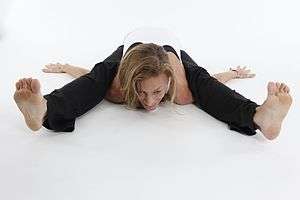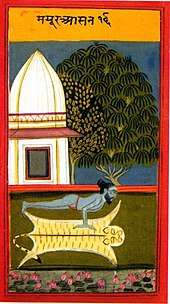Kurmasana
Kurmasana (Sanskrit: कूर्मासन; IAST: kūrmāsana), Tortoise Pose,[1] or Turtle Pose[2] is a sitting forward bending asana in hatha yoga and modern yoga as exercise.

Etymology and origins
.jpg)
The name comes from the Sanskrit कूर्म Kūrma, "turtle" or "tortoise"[3] and आसन Āsana, "posture" or "seat".[4]
Uttana Kurmasana is described in the ancient, c. 7th century Ahirbudhnya Saṃhitā,[5] and illustrated in the 19th century Jogapradipika[6] and Sritattvanidhi.[7]
The modern Kurmasana is described in B. K. S. Iyengar's 1966 Light on Yoga. Iyengar states that the asana is dedicated to Kurma, the tortoise incarnation of the god Vishnu.[8]
Description
To enter kūrmāsana a practitioner sits with the legs outstretched, feet as wide apart as possible. The knees are bent slightly, keeping the heels in contact with the floor. The body is leaned forward from the hips and the hands slid under the knees. The body leans forward (bending at the hips) to allow the hands and arms to slide sideways and backward (under the knees) until the elbows lie near the back of the knees. The heels are pushed forward and legs are straightened as much as possible. The forehead or chin is brought to touch the floor. The arms are further brought around the back to interlock the hands under the buttocks.[9][8]
.jpg)
Variations
Variations of Kūrmāsana include:
- Supta Kūrmāsana (Sleeping Tortoise Pose) has the forehead on the floor, the feet crossed behind the head, and the arms reaching around the legs, hands clasped behind the back.[10][11]
- Uttana Kūrmāsana (Upside-Down Tortoise Pose) has the arms threaded through the crossed legs as in Kukkutasana (Cockerel Pose), the back on the ground, and the palms of the hands on the neck.[12]
See also
- Garbha Pindasana - the same limb positions, but with the body upright, balancing
- List of asanas
References
- Gray 2008, p. 59.
- Ramaswami & Krishnamacharya 2005, p. 77.
- "Kurmasana - AshtangaYoga.info". Retrieved 2011-04-11.
- Sinha, S. C. (1996). Dictionary of Philosophy. Anmol Publications. p. 18. ISBN 978-81-7041-293-9.
- Mallinson, James (9 December 2011). "A Response to Mark Singleton's Yoga Body by James Mallinson". Retrieved 4 January 2019. revised from American Academy of Religions conference, San Francisco, 19 November 2011.
- Bühnemann, Gudrun (2007). Eighty-Four Asanas in Yoga: A Survey of Traditions. New Delhi: D. K. Printworld. p. 63. ISBN 978-8124604175.
- Sjoman 1999, pp. 81, Plate 15 (pose 85).
- Iyengar 1979, pp. 288–291.
- Saraswati 1996, p. 328.
- "Supta Kurmasana". Ashtanga Yoga. Archived from the original on 4 March 2011. Retrieved 4 November 2011.
- Iyengar 1979, pp. 291–292.
- Swami Kripalvananda (2017). Asana and Mudra. Red Elixir. p. section 58. ISBN 978-1944037796. OCLC 1106088756.
Sources
- Gray, Alexandra (2008). The Yoga Teacher. Grove Press. ISBN 978-0-8021-7055-2.CS1 maint: ref=harv (link)
- Iyengar, B. K. S. (1979) [1966]. Light on Yoga: Yoga Dipika. Thorsons. ISBN 978-1855381667.CS1 maint: ref=harv (link)
- Ramaswami, Srivatsa; Krishnamacharya, T. (2005). The Complete book of Vinyasa Yoga: An authoritative presentation, based on 30 years of direct study under the legendary yoga teacher Krishnamacharya. Da Capo Press. ISBN 978-1-56924-402-9.CS1 maint: ref=harv (link)
- Saraswati, Swami Satyananda (1996) [1969]. Asana Pranayama Mudra Bandha (Third revised ed.). Munger, Bihar, India: Yoga Publications Trust. ISBN 81-86336-14-1.CS1 maint: ref=harv (link)
- Sjoman, Norman E. (1999) [1996]. The Yoga Tradition of the Mysore Palace (2nd ed.). Abhinav Publications. ISBN 81-7017-389-2.CS1 maint: ref=harv (link)
_from_Jogapradipika_1830_(detail).jpg)

